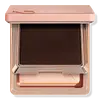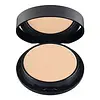Natasha Denona HY-GLAM Powder Foundation Versus Sephora Collection Best Skin Ever Matte Powder Foundation
What's inside
What's inside
 Key Ingredients
Key Ingredients

No key ingredients
 Benefits
Benefits

 Concerns
Concerns

No concerns
 Ingredients Side-by-side
Ingredients Side-by-side

Synthetic Fluorphlogopite
Dimethicone
EmollientCI 77499
Cosmetic ColorantCI 77492
Cosmetic ColorantMica
Cosmetic ColorantCI 77491
Cosmetic ColorantAluminum Hydroxide
EmollientCI 15850
Cosmetic ColorantHydrogen Dimethicone
Potassium Sorbate
PreservativeChlorphenesin
AntimicrobialCaprylic/Capric Triglyceride
MaskingPersea Gratissima Oil
Skin ConditioningTetrasodium EDTA
Rubus Idaeus Leaf Extract
Skin ConditioningTriethoxycaprylylsilane
CI 77891
Cosmetic ColorantSynthetic Fluorphlogopite
Dimethicone
EmollientNylon-12
Polypropylene
CI 77891
Cosmetic ColorantZinc Stearate
Cosmetic ColorantCI 77492
Cosmetic ColorantMethylpropanediol
SolventDiisostearyl Malate
EmollientCI 77491
Cosmetic ColorantSodium Dehydroacetate
PreservativeCI 77499
Cosmetic ColorantCaprylyl Glycol
EmollientCaprylic/Capric Triglyceride
MaskingIllite
AbrasiveHelianthus Annuus Seed Oil
EmollientDimethicone Crosspolymer
Emulsion StabilisingPhenylpropanol
MaskingCI 15850
Cosmetic ColorantChlorella Vulgaris Extract
Skin ConditioningRosmarinus Officinalis Leaf Extract
AntimicrobialSynthetic Fluorphlogopite, Dimethicone, Nylon-12, Polypropylene, CI 77891, Zinc Stearate, CI 77492, Methylpropanediol, Diisostearyl Malate, CI 77491, Sodium Dehydroacetate, CI 77499, Caprylyl Glycol, Caprylic/Capric Triglyceride, Illite, Helianthus Annuus Seed Oil, Dimethicone Crosspolymer, Phenylpropanol, CI 15850, Chlorella Vulgaris Extract, Rosmarinus Officinalis Leaf Extract
Ingredients Explained
These ingredients are found in both products.
Ingredients higher up in an ingredient list are typically present in a larger amount.
This ingredient is an emollient, solvent, and texture enhancer. It is considered a skin-softener by helping the skin prevent moisture loss.
It helps thicken a product's formula and makes it easier to spread by dissolving clumping compounds.
Caprylic Triglyceride is made by combining glycerin with coconut oil, forming a clear liquid.
While there is an assumption Caprylic Triglyceride can clog pores due to it being derived from coconut oil, there is no research supporting this.
Learn more about Caprylic/Capric TriglycerideCi 15850 is the pigment color red. It is an azo dye and created synthetically.
Azo dyes need to be thoroughly purified before use. This allows them to be more stable and longer-lasting.
This ingredient is common in foundations, lipsticks, and blushes. This color is described as brown/orangey red.
It has many secondary names such as Red 6 and Red 7. According to a manufacturer, Red 6 usually contains aluminum.
Learn more about CI 15850Ci 77491 is also hydrated iron III oxide. It's sole purpose is to give a red/pink hue to products.
Iron III oxides are classified as inorganic chemicals for coloring.
Synthetically created Ci 77491 is considered safer than those naturally found. This is because the synthetically created version may contain less impurities. Iron oxides are generally non-toxic and non-allergenic.
Learn more about CI 77491Ci 77492 is also hydrated iron III oxide. It's sole purpose is to give a yellow hue to products.
Iron III oxides are classified as inorganic chemicals for coloring.
Synthetically created Ci 77492 is considered safer than those naturally found. This is because the synthetically created version may contain less impurities. Iron oxides are generally non-toxic and non-allergenic.
Learn more about CI 77492Ci 77499 is also hydrated iron III oxide. It is created from mixing red and black iron oxides. This helps give shades of darkness to a product.
Iron III oxides are classified as inorganic chemicals for coloring.
Ci 77891 is a white pigment from Titanium dioxide. It is naturally found in minerals such as rutile and ilmenite.
It's main function is to add a white color to cosmetics. It can also be mixed with other colors to create different shades.
Ci 77891 is commonly found in sunscreens due to its ability to block UV rays.
Learn more about CI 77891Dimethicone is a type of synthetic silicone created from natural materials such as quartz.
What it does:
Dimethicone comes in different viscosities:
Depending on the viscosity, dimethicone has different properties.
Ingredients lists don't always show which type is used, so we recommend reaching out to the brand if you have questions about the viscosity.
This ingredient is unlikely to cause irritation because it does not get absorbed into skin. However, people with silicone allergies should be careful about using this ingredient.
Note: Dimethicone may contribute to pilling. This is because it is not oil or water soluble, so pilling may occur when layered with products. When mixed with heavy oils in a formula, the outcome is also quite greasy.
Learn more about DimethiconeSynthetic Fluorphlogopite is the synthethic version of mica. It consists of fluorine, aluminum and silicate.
Synthetic Fluorphlogopite is used to add volume to products.
It is considered non-irritating on the skin.
Learn more about Synthetic Fluorphlogopite